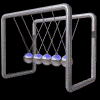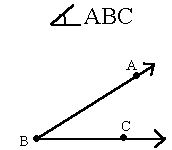| The side of an angle that is
started at would be called the initial
side, and the side that an angle ended
at would be called the terminal side.
The measure of ABC is written mABC. |
When measuring angles, you usually
go counterclockwise, starting where the 3 would be on a clock. That would
be called a zero angle
because there is nothing in it - just a single ray going directly to the
right. The next important type of angle is called the acute
angle. An acute angle is an angle whose
measure is in between 0 and 90 degrees. An example would be the 45 degree
angle in the picture. The next important type of angle is the right
angle. This is probably the most important
type of angle there is because of all the things that you can do with one.
A right angle is an angle whose measure is exactly 90 degrees.
. |
Continuing around the circle,
next is the obtuse angle.
An obtuse angle is an angle whose measure is between 90 and 180 degrees
(the 135 degree angle in the diagram for example). The last major kind
of angle is the straight angle.
A straight angle is an angle that measures exactly 180 degrees (the two
rays form a straight line). A negative angle is also possible when you
go clockwise instead of counterclockwise.
. |
Here are a few more terms that
you should know. Supplementary angles
are two angles whose measures combined equal 180 degrees. Complementary
angles are two angles whose measures combined
equal 90 degrees.
. |
|
For more information about angles
and other mathematical concepts, check out these sites on the WorldWideWeb
InteractiveLearningNetwork
/ Mathforum
/ AcademicInfoNet
|



